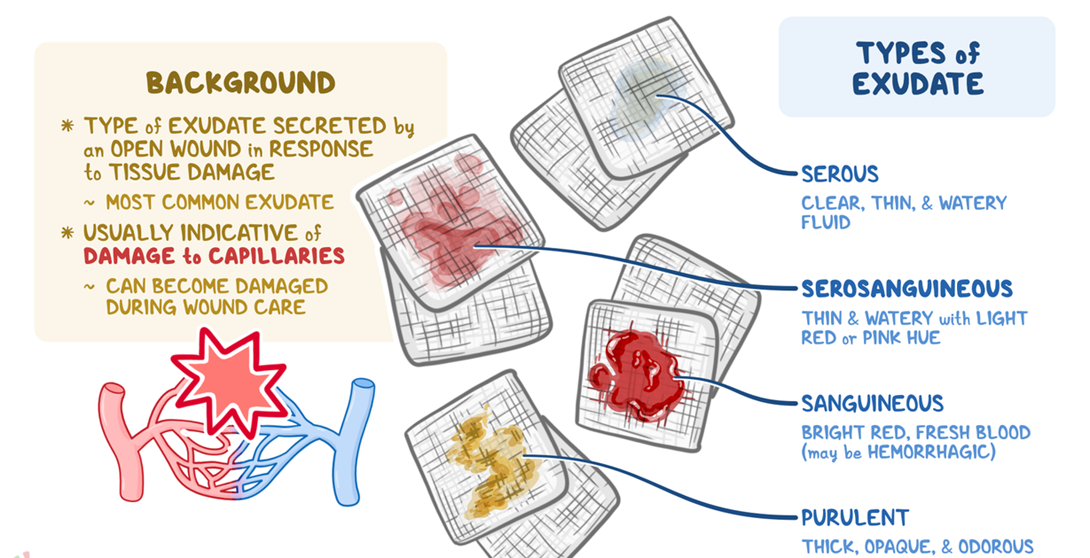A wound has a bloodtinged liquid that is dripping from the surgical site. How does the nurse document this finding?
Purulent exudate
Serous exudate
Serosanguineous exudate
Sanguineous exudate
The Correct Answer is C
Choice A reason: Purulent exudate is a thick, yellowgreen, or brown pus that indicates infection. It is not bloodtinged and does not drip from the wound.
Choice B reason: Serous exudate is a clear, thin, and watery fluid that is normal in the inflammatory stage of wound healing. It does not contain blood cells and is not red in color.
Choice C reason: Serosanguineous exudate is a pink or red fluid that contains both serum and blood. It is common in the proliferative stage of wound healing and may drip from the wound due to increased capillary permeability.
Choice D reason: Sanguineous exudate is a bright or dark red fluid that consists mostly of blood. It indicates active bleeding and is usually seen in traumatic or surgical wounds. It is not diluted with serum and is more viscous than serosanguineous exudate.

Nursing Test Bank
Naxlex Comprehensive Predictor Exams
Related Questions
Correct Answer is A
Explanation
Choice A reason: Wearing a gown is the correct answer, because it is the appropriate PPE for contact precautions, which are required for clients who have MRSA. MRSA is a type of bacteria that is resistant to many antibiotics and can cause serious infections in the skin, blood, lungs, or other organs. MRSA can be transmitted by direct or indirect contact with the infected wound or contaminated surfaces. Wearing a gown can protect the nurse's clothing and skin from exposure to MRSA.
Choice B reason: Wearing sterile gloves is not the correct answer, because it is not the appropriate PPE for contact precautions, which are required for clients who have MRSA. Sterile gloves are used for sterile procedures, such as inserting a catheter or changing a dressing, not for routine assessments, such as checking the pulse. Wearing sterile gloves can be wasteful and unnecessary, and it does not provide adequate protection from MRSA.
Choice C reason: Wearing a PAPR mask is not the correct answer, because it is not the appropriate PPE for contact precautions, which are required for clients who have MRSA. PAPR stands for powered airpurifying respirator, and it is a type of mask that filters the air and provides positive pressure to the wearer. PAPR masks are used for airborne precautions, which are required for clients who have diseases that can be spread through the air, such as tuberculosis or measles, not for clients who have MRSA.
Choice D reason: Wearing a surgical mask is not the correct answer, because it is not the appropriate PPE for contact precautions, which are required for clients who have MRSA. Surgical masks are used for droplet precautions, which are required for clients who have diseases that can be spread through respiratory droplets, such as influenza or pertussis, not for clients who have MRSA.
Correct Answer is C
Explanation
Choice A reason: This is not the best intervention because it is timeconsuming and may not be feasible in some situations. Writing down the message can also be impersonal and may not convey the tone or emotion of the speaker. The nurse should use verbal communication as much as possible and supplement it with nonverbal cues, such as gestures, facial expressions, and eye contact.
Choice B reason: This is an incorrect intervention because it can be annoying and ineffective. Talking loudly in the impaired ear can cause discomfort and distortion of the sound. It can also damage the remaining hearing in the ear. The nurse should not shout or raise their voice, but rather speak at a normal volume and enunciate clearly.
Choice C reason: This is the best intervention because it enhances the quality and clarity of the verbal message. Speaking slowly and clearly while facing the client allows the client to see the nurse's mouth movements and facial expressions, which can help them understand the words and the meaning. The nurse should also avoid covering their mouth or chewing gum while speaking.
Choice D reason: This is not the best intervention because it can be inconvenient and impractical. Talking in a regular voice in the good ear may require the nurse to move around the client or position themselves in a certain way. It can also make the client feel isolated or singled out. The nurse should try to communicate with the client in a way that is comfortable and respectful for both parties.
Whether you are a student looking to ace your exams or a practicing nurse seeking to enhance your expertise , our nursing education contents will empower you with the confidence and competence to make a difference in the lives of patients and become a respected leader in the healthcare field.
Visit Naxlex, invest in your future and unlock endless possibilities with our unparalleled nursing education contents today
Report Wrong Answer on the Current Question
Do you disagree with the answer? If yes, what is your expected answer? Explain.
Kindly be descriptive with the issue you are facing.
